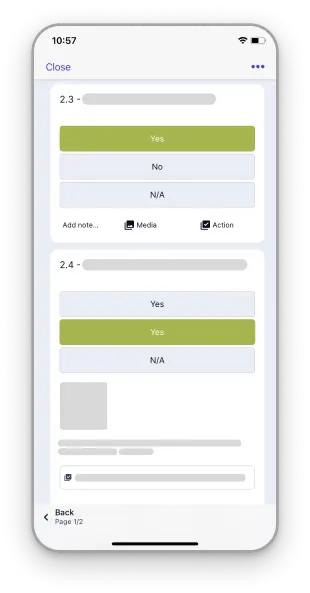What is a Workplace Risk Assessment?
A workplace risk assessment is an investigation of the different hazards that are present in a workplace and the risks they pose to the health and safety of the people working there. Workplace risk assessments also help employers develop effective risk control measures that eliminate or mitigate hazards.
Why Perform Workplace Risk Assessments?
Whether it’s an office setting, work-from-home setup, or a high-risk environment, performing a workplace risk assessment is key to maintaining the health and safety of employees. As a company’s biggest asset, employees are vital to the success and stability of the business.
Advantages
- Effective risk control measures are developed and implemented against known hazards and risks
- Workplace hazards and risks no longer negatively affect employees due to the risk control measures put in place
- The productivity of employees improves as a result and so does the quality of their work
- The business operates more efficiently and is able to withstand external factors better than its competitors
- Over time, the business becomes a leader in its industry due to its good reputation and years of experience
Disadvantages
- Lack of appropriate risk control measures in place because workplace hazards and risks are not realized
- Workplace hazards and risks continue to negatively affect employees by endangering their health and safety
- Lower employee productivity and/or quality of work due to the negative effects of hazards and risks
- The business suffers from operational inefficiencies and becomes more vulnerable to external factors
- The business is unable to recover from a major event and closes down
Is It a Regulatory Standard?
Beyond continued business operations, unhindered by incidents caused by hazards, another important reason to perform a workplace risk assessment is that it’s a legal requirement in most countries and regions, including the following:
UK
In the UK, workplace risk assessments are required under the Management of Health and Safety at Work Regulations 1999 (MHSWR). Based on guidance from the Health and Safety Executive (HSE) and Regulation 3 of MHSWR, employers in the UK have to do the following:
- Identify what could cause injury or illness in your business (hazards)
- Decide how likely it is that someone could be harmed and how seriously (the risk)
- Take action to eliminate the hazard, or if this isn’t possible, control the risk
- Review the workplace risk assessment when there is reason to suspect that it has become obsolete or there has been a significant change in the matters to which it relates
- Make changes required by the result of such review
Additionally, if employers in the UK have 5 or more employees, they must record the following:
- Significant findings of the workplace risk assessment
- Any group of employees identified as being especially at risk
US
In the US, workplace risk assessments, more commonly known as hazard assessments, are required under the Code of Federal Regulations (CFR), Title 29, Part 1910, Subpart I, Occupational Safety and Health Administration (OSHA) Standard 132.
Canada
Similarly in Canada, workplace risk assessments are also known as hazard assessments and are required under Part XIX of Canada Occupational Health and Safety Regulations.
Australia
In Australia, while hazard or risk assessments aren’t specifically required, Part 2 of the Work Health and Safety (WHS) Act 2011 states that employers must ensure the health and safety of their employees.
How to Perform Workplace Risk Assessment in 5 Steps
This is a general outline to read through before performing a workplace risk assessment:
1. Decide on the focus of the workplace risk assessment
This step is crucial in providing both direction and clarity. Start by defining the goal of the workplace risk assessment. Use the following questions as a guide:
- Why is this workplace risk assessment needed? (aside from being legally required)
- How could this workplace risk assessment help the business and its employees?
- What is the workplace risk assessment’s intended result, effect, or output?
Next, establish the scope of the workplace risk assessment. Don’t skip this part to avoid taking more time than necessary. Then choose who will be involved in the workplace risk assessment and their level of responsibility/participation. Lastly, finalize details such as when and where the workplace risk assessment will be performed.
2. Identify hazards
There are many different types of hazards, with some more common in certain settings. For example, chemical hazards are usually only found in laboratories or processing plants, while psychosocial hazards such as stress, harassment, or violence are frequently present and/or identified in office settings.
Once all hazards in the workplace have been identified, think of the risk/s that each hazard can contribute to or cause. Any form of danger or harm that could possibly occur can be considered a risk. Ensure that all risks have been recorded before proceeding with the next step.
3. Evaluate risks
The most popular method to evaluate risks is to estimate the likelihood of a risk occurring and the severity of the consequences if the risk were to occur. After determining the likelihood and consequences, use a risk matrix like the one below to identify its risk level.

Risk Matrix for Evaluating Risks
4. Develop risk control measures
For high-level risks, if the hazards relating to those risks cannot be eliminated, develop risk control measures. Risk control measures can be as simple as focusing on those high-level risks or as complex as needed, depending on the type of work, organizational priorities, workflows, structure, and goals.
5. Regularly review the workplace risk assessment
Aside from being good practice, regularly reviewing the workplace risk assessment helps uncover the different issues experienced by employees that affect their work. By proactively addressing these issues, employers prevent more serious problems from occurring.


